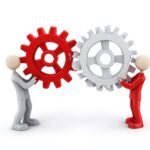In today’s fast-paced business environment, accurate sales forecasting is crucial for success. The CRM (Customer Relationship Management) module in SAP Business One is designed to enhance the precision of sales forecasts, giving businesses the insights they need to make informed decisions. This blog will delve into the features and benefits of the CRM module and how it revolutionizes sales forecasting accuracy.
Key Features of the CRM Module
1. Customer Segmentation and Profiling: The CRM module in SAP Business One allows businesses to segment their customers based on various criteria such as demographics, purchase history, and behavior. This segmentation is essential for identifying patterns and trends that contribute to accurate sales forecasting. By understanding the different customer segments, businesses can tailor their sales strategies to meet specific needs and preferences, ultimately improving forecast accuracy.
2. Sales History and Trend Analysis: One of the standout features of the CRM module is its ability to analyze historical sales data. By examining past sales performance, businesses can identify trends and patterns that help predict future sales. This trend analysis is vital for anticipating demand fluctuations and making proactive adjustments to sales strategies. The CRM module provides detailed reports and visualizations that make it easy to interpret sales data and derive actionable insights.
3. Integration with Other Modules: The CRM module seamlessly integrates with other modules such as inventory and finance, ensuring that all relevant data is considered when generating sales forecasts. This integration provides a holistic view of the business, minimizing discrepancies and enhancing the accuracy of forecasts. For example, inventory data can be used to predict product availability, while financial data can help assess the impact of sales on revenue and profitability.
4. Real-time Data Access: With real-time access to customer data and sales activities, businesses can make timely adjustments to their sales forecasts. The CRM module provides up-to-date information on customer interactions, sales transactions, and market trends, allowing businesses to respond quickly to changes in the market. This agility is essential for capitalizing on new opportunities and staying ahead of the competition.
5. Predictive Analytics: The CRM module leverages advanced predictive analytics to generate accurate sales forecasts. By analyzing historical data and identifying patterns, the system can predict future sales with a high degree of accuracy. Predictive analytics tools use machine learning algorithms to continuously refine their predictions, ensuring that businesses have the most reliable information at their fingertips.
Benefits of Improved Sales Forecasting
1. Better Inventory Management: Accurate sales forecasting enables businesses to optimize their inventory levels, reducing the risk of overstocking or stockouts. By predicting demand more accurately, businesses can maintain the right amount of inventory to meet customer needs without tying up excess capital in unsold stock. This optimization leads to cost savings and improved cash flow.
2. Increased Revenue and Profitability: By aligning production and sales strategies with accurate forecasts, businesses can maximize their revenue and profitability. Accurate sales forecasts help identify high-potential opportunities, allowing businesses to allocate resources effectively and prioritize efforts that generate the most significant returns. This strategic approach drives revenue growth and enhances overall profitability.
3. Enhanced Customer Satisfaction: With precise sales forecasts, businesses can better meet customer demands and expectations. By having the right products available at the right time, businesses can reduce lead times and improve order fulfillment. This responsiveness leads to higher customer satisfaction and loyalty, fostering long-term relationships and repeat business.
4. Strategic Planning and Decision Making: Accurate sales forecasting provides a solid foundation for strategic planning and decision making. Businesses can set realistic goals, allocate resources efficiently, and mitigate risks effectively. With reliable sales forecasts, businesses can develop long-term plans that align with market trends and customer needs, ensuring sustainable growth and success.
Implementing SAP Business One CRM for Sales Forecasting
1. Assessing Business Needs: The first step in implementing SAP Business One CRM for sales forecasting is to assess the specific needs and goals of the business. This assessment involves identifying key pain points, defining the scope of the CRM implementation, and setting clear objectives for what the business hopes to achieve with improved sales forecasting.
2. Customizing the CRM Module: SAP Business One CRM offers a high degree of customization to meet the unique requirements of each business. This customization includes setting up customer segments, defining sales stages, and configuring reports and dashboards. By tailoring the CRM module to the business’s specific needs, businesses can ensure that they get the most out of the system.
3. Training and Onboarding: To fully leverage the benefits of SAP Business One CRM, businesses need to invest in training and onboarding for their sales teams. This training includes educating team members on how to use the CRM module, interpret sales data, and generate accurate forecasts. Continuous training ensures that the sales team stays updated with the latest features and best practices.
4. Continuous Monitoring and Improvement: Implementing SAP Business One CRM is not a one-time effort. Businesses need to continuously monitor the system’s performance, analyze sales data, and make adjustments as needed. This continuous improvement process ensures that the CRM module remains effective and aligns with the evolving needs of the business.
Conclusion
In conclusion, the CRM module in SAP Business One significantly enhances sales forecasting accuracy through its advanced features and capabilities. By leveraging customer segmentation, trend analysis, real-time data access, and predictive analytics, businesses can make informed decisions that drive growth and success. Improved sales forecasting leads to better inventory management, increased revenue, enhanced customer satisfaction, and strategic planning. For businesses looking to stay competitive in today’s market, implementing SAP Business One CRM is a game-changer.







